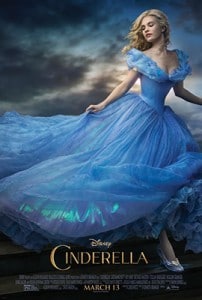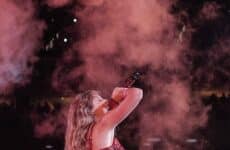By Marrissa Ballard | Staff Writer
This March, Disney released the greatly anticipated, live-action adaptation of Cinderella. Teenagers, adults, and young kids alike flocked to theatres to see this updated version of a classic tale.
The film is expertly shot and lit, and features beautiful costumes, effects, and makeup. The magic from the cartoon comes to life in this adaptation with the help of computer generated images (CGI) and green screen.
The actors bring this film to a new level, with Cate Blanchett as the Evil Stepmother and Helena Bonham Carter as the Fairy Godmother. These talented women bring classic characters to life, either with subtly arched brows or dramatic wand-waving.
Some scenes or moments are drawn out and slow the pacing of the film considerably. For example, the scene where Cinderella arrives at the ball and slowly descends the stairs was far too long and slowed the action down.
Because the movie is an adaptation of the original cartoon, the plot follows the original, familiar pattern. However, the movie adds more scenes with the Prince, including a sub-plot about his relationship with his father. The movie seems evenly split between their two plotlines.
It is nice to see more of the Prince, but his sub-plot stole the film for me. I was more interested in seeing him fight his father’s wishes than watching Cinderella clean and cook. This might be because his sub-plot was new, as the cartoon never made any mention of the Prince being pressured to love a princess. His part in the original cartoon was small, while his character in the adaptation grows and changes.
Disney has been criticized for its messages before, but this film does nothing to improve upon the troubling title character. The overall message of the film, repeated plenty of times within dialogue and flashback, is to “have courage and be kind.” This becomes Cinderella’s mantra, which helps her deal with her stepmother’s cruelty, and become brave enough to attend the ball.
The film seems to imply that Cinderella was taught to simply “be kind” no matter what happens to her. This is especially troubling because the act of being kind leads Cinderella into a life of servitude and oppression at the hands of her cruel sisters and stepmother.
Cinderella’s story, and her behavior, sends the message that women should just accept any actions towards them and never fight back. Cinderella even goes along with this treatment, immediately falling into the servant role as soon as her father dies. Several scenes feature the stepmother and sisters dropping things just to see if Cinderella will clean them up. It is as if she was predisposed to simply cleaning up after everyone, even though up to this point in her life she has lived in a wealthy home with servants.
I found myself asking throughout the film – why does Cinderella accept this treatment? Why does she immediately clean up after these women? She’s perfectly capable of riding a horse into town, but it never crosses her mind to abandon the women who are terrorizing her? And why does Ella accept the name Cinderella, given to her by her rotten sisters? Why would she tell the prince that her name is Cinderella, and not Ella?
Cinderella emerges as a submissive character, whose only act of rebellion is to allow a man to save her and defend her from the cruel people of the world. We never learn why the stepmother hates her so much, or why Cinderella allows them to take advantage of her in her own house. She simply allows people to guide her or treat her however they like, and accepts their behavior no matter how cruel.
Since the film features so much of the Prince, we can compare his story to Cinderella’s. Unlike Cinderella, the Prince never bows to adversity, and fights against the things that stand in his way. When his father orders him to marry a princess instead of a common girl, the Prince fights back and takes control of his marriage.
The plotline of the Prince also includes an antagonist similar to the stepmother, a greedy and powerful Duke. The Duke is responsible for visiting each house and having the women try on the glass slipper. One of the pivotal moments of the film, which had the whole audience cheering, was when the Prince catches the Duke in the act of lying.
The Prince emerges as a strong, dominant character who takes control of his life and defeats his adversaries. He even manages to convince his father that he should be able to marry for love, instead of power. The Prince is also developed and complex, and has an emotional side that the audience gets to enjoy.
Where Cinderella, our supposed heroine, is submissive and one-dimensional, the Prince is heroic, dominant, and complex. By the end of the film, I felt like it was more his story than hers.
The film, while beautifully shot, lit, and acted, sends a deeply problematic message about gender roles and how women should behave. In this way, it joins the Disney collection and tradition, never once questioning or interacting with its source.














